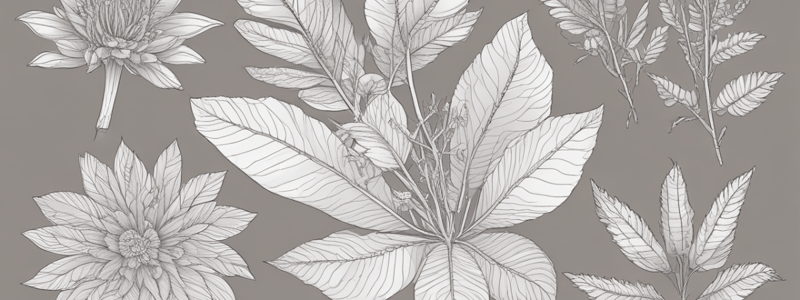Podcast
Questions and Answers
What is similar between seeds in pinecones and spores in ferns and mosses?
What is similar between seeds in pinecones and spores in ferns and mosses?
- They are both similar to tiny fertilized eggs (correct)
- They are both found in flowers
- They are both types of leaves
- They are both covered in fruits
What is unique about the way ferns and mosses reproduce?
What is unique about the way ferns and mosses reproduce?
- They release millions of spores into the air (correct)
- They produce flowers that attract bees
- They have roots that absorb water
- They produce seeds in cones
What is a characteristic that algae shares with bacteria?
What is a characteristic that algae shares with bacteria?
- They both have roots and stems
- They both produce seeds
- They both make fruits
- Some can be a single cell and reproduce by cell division (correct)
Why do biologists not consider algae to be a plant?
Why do biologists not consider algae to be a plant?
What is a common name for pine trees, spruce, firs, and cedar?
What is a common name for pine trees, spruce, firs, and cedar?
What is the main characteristic that distinguishes flowering plants from non-flowering plants?
What is the main characteristic that distinguishes flowering plants from non-flowering plants?
What is the term used to describe plants that grow from seeds with one leaf inside?
What is the term used to describe plants that grow from seeds with one leaf inside?
What is the primary way in which plants make their food?
What is the primary way in which plants make their food?
Which type of plant is characterized by the presence of branched veins in their leaves?
Which type of plant is characterized by the presence of branched veins in their leaves?
What is the term used to describe plants that do not produce flowers?
What is the term used to describe plants that do not produce flowers?
Study Notes
Plant Classification
- Plants can be grouped into two main categories, just like animals, based on their characteristics.
- Plants do not have backbones, but they all make food from the sun through photosynthesis.
Flowering Plants (Angiosperms)
- Flowering plants produce covered seeds and fruits.
- Examples of flowering plants include watermelon, lilies, orchids, grasses, corn, wheat, daisies, roses, sunflowers, and apple blossoms.
- Monocots are flowering plants that grow from seeds with one leaf inside, with parallel veins in their leaves.
- Dicots are flowering plants that grow from seeds with two leaves inside, with branched veins in their leaves.
Plants Without Flowers (Gymnosperms)
- Plants without flowers include conifers, ferns, and mosses.
- Conifers have seeds that sit in cones, and include trees like pine, spruce, firs, and cedar.
- Ferns and mosses release spores into the air to reproduce, similar to mushrooms.
- Spores are like tiny fertilized eggs, similar to seeds, but smaller and spread by wind.
Algae
- Algae are green, use the sun for photosynthesis, but are not considered plants by most biologists.
- Algae are similar to bacteria, some being single-celled and reproducing by cell division.
- Some algae have spores, but lack roots, stems, and leaves.
Studying That Suits You
Use AI to generate personalized quizzes and flashcards to suit your learning preferences.
Description
Learn about the main groups of plants, similar to how animals are classified. Discover how plants make food from the sun and more!




